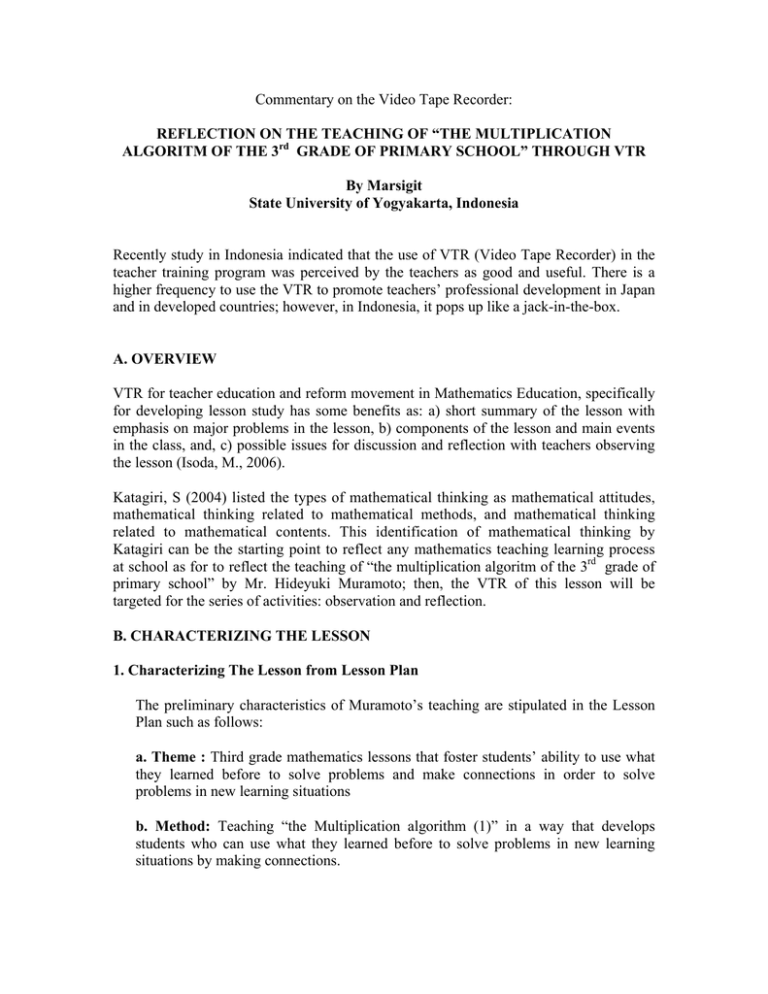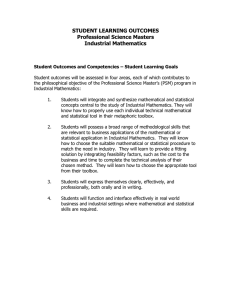Commentary on the Video Tape Recorder: ALGORITM OF THE 3
advertisement

Commentary on the Video Tape Recorder: REFLECTION ON THE TEACHING OF “THE MULTIPLICATION ALGORITM OF THE 3rd GRADE OF PRIMARY SCHOOL” THROUGH VTR By Marsigit State University of Yogyakarta, Indonesia Recently study in Indonesia indicated that the use of VTR (Video Tape Recorder) in the teacher training program was perceived by the teachers as good and useful. There is a higher frequency to use the VTR to promote teachers’ professional development in Japan and in developed countries; however, in Indonesia, it pops up like a jack-in-the-box. A. OVERVIEW VTR for teacher education and reform movement in Mathematics Education, specifically for developing lesson study has some benefits as: a) short summary of the lesson with emphasis on major problems in the lesson, b) components of the lesson and main events in the class, and, c) possible issues for discussion and reflection with teachers observing the lesson (Isoda, M., 2006). Katagiri, S (2004) listed the types of mathematical thinking as mathematical attitudes, mathematical thinking related to mathematical methods, and mathematical thinking related to mathematical contents. This identification of mathematical thinking by Katagiri can be the starting point to reflect any mathematics teaching learning process at school as for to reflect the teaching of “the multiplication algoritm of the 3rd grade of primary school” by Mr. Hideyuki Muramoto; then, the VTR of this lesson will be targeted for the series of activities: observation and reflection. B. CHARACTERIZING THE LESSON 1. Characterizing The Lesson from Lesson Plan The preliminary characteristics of Muramoto’s teaching are stipulated in the Lesson Plan such as follows: a. Theme : Third grade mathematics lessons that foster students’ ability to use what they learned before to solve problems and make connections in order to solve problems in new learning situations b. Method: Teaching “the Multiplication algorithm (1)” in a way that develops students who can use what they learned before to solve problems in new learning situations by making connections. c. Goals of the Unit: To be able to think about how to carry out the calculation of a 2-digit number x a 1-digit number by using what was previously learned about multiplication (mathematical thinking). d. Scenario of Teaching 1) Developing teaching that help students to become aware of the connection between what they learned before and what they are learning now and use previously learned knowledge to overcome obstacles in a new situation. 2) Connections between previously learned knowledge and new learning 3) Representing a problem situation with diagrams based on the idea of “how many times as much as a unit quantity” consistently and helping students to understand the situation and solution of the problem more clearly. The following posed problem is: How many dots are there? 4) Developing lessons that incorporate this idea and help students to use the diagram to think 2. Characterizing the Lesson from VTR a. The problem of video taping - The quality of pictures are relatively good - The single camera made the limitation of landscaping the class - The small caption in the screen helps to catch more the picture of the class b. The components of the lesson - The whole class teaching has reduced the complexity of class interaction into the simple or linear pattern of interaction between teacher and students. - Highlighting the certain ideas from certain student has ignored the other students’ ideas. - Highlighting the certain aspect of mathematical thinking of a certain students endanger the total management of the class. c. Encouraging and uncovering students’ mathematical thinking - Teacher’s effort in encouraging and uncovering students’ mathematical thinking were effective enough. - Teacher’s effort in serving individual students has not been effective yet. - Some of the students were able to perform mathematical thinking - Teacher was able to achieve the goal of the lesson - Mathematical thinking of a certain students can be a model for others. - Different students, in the same allocation of time, did similar problems by employing different methods to cultivate the similar results. - Students’ discussion among themselves has not emerged yet. - Students’ involvements in classroom management were still limited. - Teacher has effectively employed the proper teaching aids. B. CONCLUSION The conclusion of the paper highlights some problems as follows: - The problem of the reduction of the complexity of classroom interaction into the simple or linear pattern between teacher and his students. - The problem of landscaping the whole classroom activities - The negative correlation between focusing a certain aspect of students thinking and reducing the variant of their learning contexts. - The problem of the pattern for the relation for promoting individual needs and the whole classroom management. - The problem of the gap amongst teachers’ effort (including methods and media), students’ findings and the concept/understanding/rational of the vertical way of calculating 23 times 3. - The problem of matching the theory of the concept of mathematical thinking and the factual condition of students’ mathematical thinking. - The problem of mathematical thinking of the lower achievement students. - The problem of exploring intrinsic, extrinsic and systemic of mathematical thinking. REFERENCE: Isoda, M. (2006). Reflecting on Good Practices via VTR Based on a VTR of Mr. Tanaka's lesson `How many blocks? Draft for APEC-Tsukuba Conference in Tokyo, Jan 15-20, 2006 Marsigit, (2006), Lesson Study: Promoting Student Thinking On TheConcept Of Least Common Multiple (LCM) Through Realistic Approach In The 4th Grade Of Primary Mathematics Teaching, in Progress report of the APEC project: “Colaborative Studies on Innovations for Teaching and Learning Mathematics in Diferent Cultures (II) – Lesson Study focusing on Mathematical Thinking -”, Tokyo: CRICED, University of Tsukuba. Shikgeo Katagiri (2004)., Mathematical Thinking and How to Teach It. in Progress report of the APEC project: “Colaborative Studies on Innovations for Teaching and Learning Mathematics in Diferent Cultures (II) – Lesson Study focusing on Mathematical Thinking -”, Tokyo: CRICED, University of Tsukuba.





